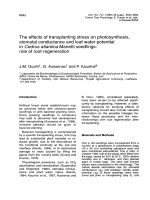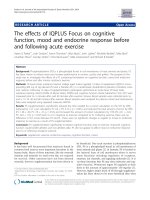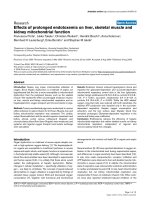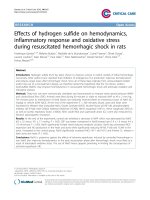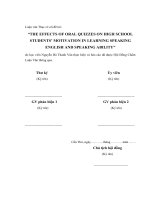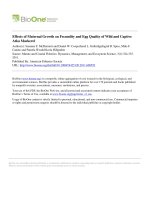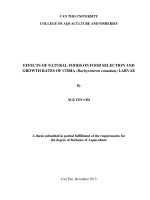EFFECTS OF GREEN BARRIERS ON EXPORTING AGRICULTURE PRODUCTS AND SEAFOOD FROM VIETNAM TO THE US MARKET
Bạn đang xem bản rút gọn của tài liệu. Xem và tải ngay bản đầy đủ của tài liệu tại đây (2.54 MB, 100 trang )
MINISTRY OF EDUCATION AND TRAINING
FOREIGN TRADE UNIVERSITY
---------***--------
DISSERTATION
EFFECTS OF GREEN BARRIERS ON EXPORTING
AGRICULTURE PRODUCTS AND SEAFOOD FROM VIETNAM
TO THE US MARKET
Major: Master Programme of International Trade Policy and Law
Nguyen Thi Bich
Ha Noi-2017
MINISTRY OF EDUCATION AND TRAINING
FOREIGN TRADE UNIVERSITY
---------***--------
DISSERTATION
Effects of green barriers on exporting agriculture products and
seafood from vietnam to the us market
Major: Master Programme of International Trade Policy and Law
Full Name: Nguyen Thi Bich
SUPERVISOR: Dr. Dinh Thi Thanh Binh
Ha Noi - 2017
ABSTRACT
I declare that this dissertation is my own work. Wheeferences.
Ha Noi, December 4th 2016
Nguyễn Thi Bich
ABSTRACT
I declare that this dissertation is my own work. Where material is obtained
from published or unpublished works, this has been fully acknowledged by citation
in the main text and inclusion in the list of references.
ACKNOWLEDGEMENT
During the essay time, I have received many supports from my lecturers,
family and all of my friends in terms of the knowledge, experience and the moral
supports. I would like to thank all teachers in Postgraduate Faculty especially Dr.
Dinh Thi Thanh Binh sincerely and gratefully for her guidance and advice during
the dissertation time. It can be sure that this study cannot be done without her help.
I also want to send thankfulness to my family and my friends, my colleges
who always besides to support and give me the inspiration for studying, encourage
me in the process of doing this thesis.
Since my knowledge, practical experience during my work time and
research is limited, so my essay contains inevitably flaws, I would like to receive
the sympathy and comments from the teachers, colleagues and readers to help me to
complete my essay better.
Ha Noi, December 4th 2016
Nguyễn Thi Bich
TABLE OF CONTENT
ABSTRACT
ACKNOWLEDGEMENT
LIST OF TABLES, CHARTS AND MAP
LIST OF ABBRIVIATIONS
INTRODUCTION ..................................................................................................... 1
CHAPTER 1: THEORITICAL AND PRACTICAL BACKGROUND OF
GREEN TRADE BARRIERS .............................................................................. 6
1.1. Overview about Green Trade Barriers ....................................................6
1.1.1. Definitionof Green Trade Barrier ..........................................................6
1.1.2. Type of Green Trade Barriers ..............................................................11
1.1.3. Functions and influences of Green Barriers on trade...........................13
1.1.3.1. Functions of Green Trade Barrier .................................................13
1.1.3.2. Influences of Green Trade Barriers on trade .................................14
1.2. Green trade barriers in the US .................................................................. 15
1.2.1. The US environmental relateted technical regulations ........................15
1.2.2. Qualifications for imported products ...................................................16
1.2.2. Some notices on importing goods of the US .......................................22
1.3. Experiences to improve exported products of some countries. ............23
1.3.1. China’s experiences .............................................................................23
1.3.2. The US’s experiences...........................................................................24
CHAPTER
2:
EFFECTS
OF
GREEN
TRADE
BARRIERS
IN
EXPORTING AGRICULTURE PRODUCTS AND SEAFOOD FROM
VIETNAM INTO THE US MARKET. ............................................................. 26
2.1. Exporting agriculture products and seafood from Vietnam into the US
market ...............................................................................................................26
2.1.1. Introduction about the US market ........................................................26
2.1.2. The trade relationship between Vietnam and the US...........................27
2.1.3. Overview of agriculture products exporting of Vietnam into the US
market.............................................................................................................30
2.1.3.1. Exporting agriculture products of Vietnam in general ..................30
2.1.3.2. Exporting agriculture products of Vietnam into the US market ...34
2.1.4. Overview of seafood exporting of Vietnam into the US market .........37
2.1.4.1. Exporting seafood of Vietnam in general .....................................37
2.1.4.2. Exporting seafood of Vietnam into the US market .......................39
2.1.5. Analysis advantages and disadvantages of Vietnam’s agriculture and
seafood production that can affect the export of Vietnam to the US market.46
2.1.5.1. Achievements ................................................................................46
2.1.5.2. SWOT analysis ..............................................................................48
2.2. Effects of US green trade barriers in exporting agriculture products
and seafood from Vietnam into the US market. ...........................................55
2.2.1. Effects of US green trade barriers on agriculture products .................56
2.2.2. Effects of US green trade barriers on seafood...................................59
2.2.3. Cases involed in Green trade barriers between Vietnam and the US ..66
2.2.3.1. In Agriculture Products ................................................................66
2.2.3.2. In Seafood (catfish) .......................................................................67
CHAPTER 3: SUGGESTED COUNTERMEASURES TO IMPROVE
VIETNAM’S EXPORT INTO THE US MARKET......................................... 69
3.1. Current regulations on Agriculture products and Seafood of Vietnam
...........................................................................................................................69
3.1.1. For Domestic production .....................................................................69
3.1.2. For Imported products..........................................................................72
3.2. Potential of Vietnam in exporting agricultural products and seafood
into the US market. ..........................................................................................73
3.3. Suggested solutions to improve Vietnam’s export capacity .................74
3.3.1. From the Vietnam’s authorities ...........................................................74
3.3.1.1. Ministry of Agriculture and Rural Development ..........................74
3.3.1.2. Ministry of Industry and Trade .....................................................77
3.3.1.3. Ministry of Science and Technology ............................................79
3.3.2. From Business Associations ................................................................80
3.3.3. From Individuals ..................................................................................83
CONCLUSION ........................................................................................................ 84
REFERENCES ........................................................................................................ 85
LIST OF TABLES, CHARTS AND MAP
Table 1:
Some Green Trade Barriers were used by the US
Table 2:
Banned substances in growing and producing
Table 3:
Approved drugs in growing and producing
Table 4:
Export – Import situation between Vietnam and the US from 2006 to
4 months of 2016
Table 5:
10 Key exported Products of Vietnam
Table 6:
Some main markets of Vietnam’s agriculture products
Table 7:
Some key agriculture products of Vietnam exported into the US
market
Table 8:
Importing seafood of the US from Jan to May of 2016
Table 9:
Value of exported Catfish by market
Table 10:
The most 5 Shrimp suppliers for US market, Jan-May/2016
Table 11:
The biggest importer of canned tuna of VN in 2015 and 2016
Table 12:
Catagories of Vietnam’s population in age
Table 13:
Number of enterprises exporting rice and containers be returned
Table 14:
The number of Vietnam’s shrimp and seafood shipments was returned
by US and reasons
Table 15
45 Vietnamese companies having right to process seafood and export
into US market
Chart 1:
Trade turnover Vietnam- US in period 1994 – 2015
Chart 2:
Vietnam’s exported products into the US market in 2015.
Chart 3:
Chart 4:
Chart 5:
Chart 6:
Export – Import turnover of Vietnam into the US market from 2006 to 4
months of 2016
Value of exporting agriculture products from 2010 to 2015
Export turnover of Coffee, Rice and Rubber from 2009 to 2016 of
Vietnam
Value of Vietnam’s agriculture products exported into the US market
from 2010 to 2015
Chart 7:
Exporting seafood of Vietnam from 2000 to 2015
Chart 8:
Importing Pangasius and Catfish from Vietnam of US
Chart 9:
Importing Catfish of US in 5 months of 2016
Chart 10:
Importing Frosen Pangasius from Vietnam
Chart 11:
Vietnam tuna exports in 2015-2016
Chart 12:
Chart 13:
Value of exporting agriculture products of Vietnam into the US from
2003 to 2005
Value of pangasius exported from Vietnam into the US from 2013 to
2015
Map 1 :
Trade Barrier System
Map 2 :
Cooperating among Ministries
LIST OF ABBRIVIATIONS
APEC
Asia-Pacific Economic Cooperation
APHIS
Animal and Health Inspection Services
ASC
Aquaculture Stepwardship Council
ASEA
N
Association of Southeast Asian Nations
BAP
Business Application program
COOL
Country of Origin Labeling
CPD
The Center for Policy Dialogue
CPSC
The United States Consumer Product Safety Commission
DOC
Department of Commerce
EPA
Environmental Protection Agency
ERTM
The environment-related trade measures
FDA
The Food and Drug Administration
FSIS
Food Safety and Inspection Services
FSMA
FDA Food Safety Modernization Act
GAC
General Administration of Customs
GATT
The General Agreement on Tariffs and Trade
GDP
Gross Domestic Product
GOC
General of Custom of Vietnam
GSO
General Statistics Office Of Vietnam
HACC
P
Hazard Analysis and Critical Control Points
HHS
Department of Health and Human Services
ISO
International Organization for Standardization
ITC
United State International Trade Comission
MARD
The Ministry of Agriculture and Rural Development
MOIT
The Ministry of Industry and Trade
MOST
The Ministry of Science and Technology
NAFT
A
NMFS
SPS
North American Free Trade Agreement
National Marine Fisharies Services
The Agreement on the Application of Sanitary and Phytosanitary
Measures
TBT
Technical Barrier to Trade Agreement
TPP
the Trans-Pacific Partnership Agreement
TREM
The trade – related – environment measures
TRIPS
The Agreement on Trade-Related Aspects of Intellectual Property Rights
US CS
United State Custom Service
US TR
United State Trade Representative
USDA
U.S. Department of Agriculture
USITC
United State International Trade Commission
VASEP Association of Seafood Export and Vietnam
WTO
World Trade Organization
1
INTRODUCTION
1. Research background
Nowadays, with the booming of globalization, it has opened potential
opportunities as well as major challenges for all countries in the world to get profits,
develop their economy in all areas of economy, culture, education, life ... owever.
Trade liberalization has played in important role in thesustainablee development of
each country, increasingspecialization in production, taking advantages of the
economic favorable conditions to help produce the quantities much larger than seftproduction. However, due to unequal level of economic development, the countries
increasingly apply economic barriers to protect domestic goods. One of the
measures applied by developed and developing countries is using the barriers
related to environmental regulations, and are known as the name of "green barrier”.
The use of green barriers on the one hand had help countries to protect domestic
production, prevent the flow of substandard goods into the domestic market and the
other hand to improve the sense of building an international production standards
health, raise awareness of environmental protection. This is also the reason for this
method is increasingly applied by almost countries in the world especially in developed
countries for all fields especially agriculture sector, which contains sensitive issue
relating to environment and people health causing serious obstacles to trading activities
between countries, particularly for developing countries such as Vietnam.
Vietnam is an agriculture countries with high percentage of agriculture sector
in total Gross domestic product (GDP), Therefore, Vietnam’s agriculture products
have been affected strongly when taking part in international relationship with other
countries. In reality, Vietnam’s export agriculture products faced a lot of difficulties
in satisfying requirement of importers, some Vietnam’s cargoes were understandard level when being checked by authorities, causing damages for Vietnam’s
economy in general and export enterprises and producers in particular. Therefore,
the study of green barriers and green barriers effects on agricultural products to
exports of Vietnam is a necessity, as Vietnam is in the process of international
economic integration. Then, helping Vietnam’s agricultural products to cope up
2
with and overcome these barriers and build up image and reputation of Vietnam's
agricultural products on world markets.
Regarding main markets for Vietnam’s agriculture products, the US has been
long- lasting and potential one, however, USA created a wide and strict system of
green barriers to imported products. These influenced much on Vietnam economy.
That is reason why I have chosen the topic: “Effects of Green Trade Barriers in
exporting agriculture products and seafood from Vietnam into the US market” for
my graduating thesis.
2. Literature review
Due to the strong popularity of Green barriers in international trade, so the
issue has attracted the attention of almost authorities, sectors, scientists domestically
and abroad. There were many essays and research articles, books at different grades
mentioned this issue can be listed as follow:
From foreign writers : Up to now, there have been three typical foreign
researchers and organizations had studied on green trade barriers, including : the
first one is working paper title “Unilateralism Europe - Environmental Trade
Barriers and threats to the prosperity of commerce are increasing” by APEC Study
Centre (Australia) which published in 2003. The topic has received high attention
of Pi C & E companies when they compiled and released book: “Handbook of
“Green barrier” in the WTO” in 2007. In addition, in 2009, the group of authors
from the Centre for Policy Dialogue Bangladesh (CPD)had paper entitled
“Environmental Barriers and WTO”. Professor David Hanson of the University of
Duquesne US published the book: “The barriers to free trade: the non-tariff barriers
in the European Union, Japan, the United States” in 2010. Lastly, in 2014, author
Emilija Miteva Kacarski had paper in the journalapplied science and business
economics titled “Non-tariff Barriers in some developing countries (the case of the
US, EU, Japan)”. However, there is no specific paper or research mentioning about
green trade barrier system in the US and effects of these barriers on Vietnam’s
export activities.
3
From domestic writer : In domestic, the number of research studying on green
barrier were big. However, most of them did not mention directly on green barriers,
they only discussed aboutenvironmental regulations in trade and similar thing.
Including : In 2005, Bui Huu Dao has writed a article titile“Improving the abilitty to
meet the regulations and international standards on environment for some export
commodities of Vietnam” publishing on the trade magazine No. 19 or Nguyen Huu
Khai has talked about the same topic in book:“Eco-labels for goods for export and
domestic consumption”. Afterward, in 2006, authors Le Hoang Lan had writen an
article in Tia Sang magazine: “Environment threatsand opportunities when joining
WTO”. In 2007, Group of authors including: Nguyen Huu Khai, Vu Thi Hien,Dao
Ngoc Tien compiled and published the book “Managing the import operation:
Mechanism, policies and measures”. In 2008, author Dao Thi Thu Giang published
the book “The measures exceed Non-tariff barriers for exports of Vietnam”. In
2012, a group of authors including: Lawyer Hoai Nam, PhD. Bui Huu Director, Dr.
Hoang Thanh Tung compiled and published the book: “Environmental Challenges
in International Trade”. In the same year, when mentioning about solutions to
improve environmental problem in trade, reseacher Dinh Van published in the
Journal his research projects of state level called: “Assessment current situation and
the proposal construction of non-tariff measures in trade in order protect the
environment”. And an essay title “Vietnamin the fight against international trade
barriers” published on Journal of the Communist Party of Doan Cong Khanh Director of Center for Business and the Environment. Lastly, in 2014, Doctor.
Nguyen Thi Tuong Anhwrote in the Journal of Finance: “Building Non - Tariffs
barriersin some countries in the world”.
Each of above researches has studied a corner of Green trade barrier such us:
Some tools in Green trade barriers – ecolable (Nguyen Huu Khai, 2005); effects of
Green trade barriers – Environment barriers to international trade in general (APEC
study center – 2003); how to adapt to and overcome environmental barriers (Bui
Huu Dao, 2005; Dao Thi Thu Giang, 2008…) However, there is no research, book
mentioning all aspects of issue and give official definition about green trade barrier.
4
3. Research question
This thesis will answer a question: “How some green trade barriers affect on
exporting agriculture products and seafood from Vietnam into the US market?”. To
solve this question, the study will:
Fistly, find and analyze some green trade barriers of the US
Secondly, examine effects of these barriers on exporting agriculture products
and seafoods of Vietnam into the US market
Lastly, give some countermeasures for authorities, enterprises and local to
satisfy not requirements of of the US market and other countries in the world.
4. Objective and scope of research
4.1. Objective of research
The research focus on how green trade barriers or environment barriers of the
US effect on Vietnam’s export activity of agriculture and seafood production and
solutions to improve Vietnam current export situation.
4.2. Scope of research
Scopes of the research include: the US green trade barriers were applied for
agriculture products and seafood; Export activity of agriculture sector of Vietnam
and effects of barriers on Vietnam’s agriculture commodities in the past.
5. Methodology of research
- Statistical discription: The topic uses statistics from the General Department
of Statistics and some information source trusted. With the support of the data
processing software to be able to assess systematically, reliable enough to serve the
purpose of the research study.
- Analyzing; comparing datas: Analytical methods help find specific points,
details of green barrier. Comparative approach helps see the differences between the
effects of green barriers of the US to agricultural export situation in Vietnam. The
results of analysis, evaluation and synthesis of obtained information are resultsof
the study metting the objectives and tasks of the topic.
5
In study, these methods were used flexibly to solve problems in the most
efficient way.
6.Structure of Research
Apart from the Introductions; Conclusion; List of references; List of
abbreviations; List of Tables and Chart. The research consists 3 main parts :
- Chapter 1: Theoretical and practical background of Green Trade barriers
- Chapter 2: Effects of green trade barriers in exporting agriculture products
and seafood from Vietnam into the US market
- Chapter 3: Suggested countermeasures to improve Vietnam’s export
activities into the US in particular and other markets.
6
CHAPTER 1: THEORITICAL AND PRACTICAL BACKGROUND OF
GREEN TRADE BARRIERS
1.1. Overview about Green Trade Barriers
1.1.1. Definitionof Green Trade Barrier
In recent years, international trade between countries has been heavily
increasing with diversify of products. When taking part in an international trade
relationship, each country has opportunities to show up its strengths as well as has
to face difficulties brought by partners, especially in relations between developing
countries and developed ones. Therefore, it is necessary for countries to set up their
own barriers in trade to protect themself.
Trade barriers are measures that governments or public authorities of a
country impose to all kinds of imported products to make imported goods or
services less competitive than locally produced goods and services. However, not
everything preventing or restricting trade can be characterised as a trade barrier.
There are two types of trade barriers popularly used in international trade : Tariff
barriers – tax on imports and exports; Non – tariff barriers -barriers that restrict
import or export of goods or services through instruments : Import/export licenses;
quotas; subsidiaries; embargo…
Nowadays, the global economy has been more and more developing; countries
begin to take much care about environmental problems and health of mankind.
Therefore, besides applying Taiff barriers in trade with foreigners, countries also
used non – tariff barriers not only to restraint imports, protect domestic producers
but also to protect environment, human’s health.
Throughout 1992 to 1996, there were a number of multilateral environmental
agreements discussing about international frameworks, however, they could not get
consistency and coherence. And, the most important issue was controlling
environmental problem in applying green trade barriers. Although debates and
controviersies exited, they got agreement of imposing green trade barriers as a nontariff barrier. Day by day, all countries become familiar to green trade barriers as a
7
method of non – tariff barrier, they are trade barriers restricting imports and exports
of good through forms of import quota; licences; embargo; origin of goods….
Up to now, there have been a number of writers and researchers had studied
on Green trade barrier. A lot of articles, newspapers were published, however, there
is no official definition of Green barrier in trade. Some authors mentioned Green
barrier in trade as followed:
According to the Ministry of Natural resources and Environment - Mai Ai
Truc’s speech in Sai Gon Liberation newspaper about main content of Green
barrier: “Strictly safe standards for food and products which directly serve people’s
live such as household appliances, textile products, footwear, plastics ...”.
According to Le Hoang Lan wrote on Tia Sang magazine, she has considered
Green barriers as Environmental measures: “Environmental measure is a system of
environmental regulations in production, from use of raw material to level of
technology in producing; from waste disposal to recovery and recycling; from
adoption of measures to reduce emissions to the implementation of environmental
management”(Le Hoang Lan, 2006).
From above definitions, it can be seen that Green Barriers are measures
including provisions relating directly or indirectly to environment such as animal
and plant quarantine and safety food. These regulations relate to environmental
protection and public health purposes. And, Environmental Barrier is an
environmental regulation with functions to protect environment and people health.
To some extend, Green Barriers can be understood widely as Environmental
Barriers.
When talking about environmental regulations in trade. In some aspect, the
concepts trade – related – environment measures (TREM)s or environment- related
– trade measues are preferred. The Economic Committee of APEC give definitions
of two terms
as:“The term trade-related-environment measures (TREMs) or
environment-related trade measures (ERTMs) are also used to refer green trade
barrier“. In one survey on the reality of TREMs and ERTMs in APEC, for
instance, the Economic Committee of APEC defines these two measures as:
8
“Trade-related environment measures have a relatively wide coverage. They refer
to environmental measures with significant trade effects, including laws,
regulations, and administrative measures as well as regional and multilateral
agreements that are formulated and implemented or signed by APEC member
economies. Environment-related trade measures refer to national trade laws,
regulations as well as administrative measures enacted to achieve a specific
environmental goal or for environmental purposes, including trade-related
measures adopted by individual economies pursuant to the multilateral
environmental agreements. Examples of ERTMs include bans, restrictions, or
permit requirements in respect of imports or exports”.
“The rade-related-environment measures (TREMs) are increasingly used as
an important measure of technical barrier system. Developing countries and
developed ones have used them popularly and efficienly to control the imports of
environment – related products and to protect domestic - related industries”. (Le
Hoang Lan, 2006).
In World Trade Orgnization (WTO), there is no Agreement on Green Trade
Barrier, however, in some Agreement; Green Trade Barrier is also mentioned in
some Agreements as followed:
Article XX of The General Agreement on Tariffs and Trade (GATT 1994):
“Subject to the requirement that such measures are not applied in a manner which
would constitute a means of arbitrary or unjustifiable discrimination between
countries where the same conditions prevail, or a disguised restriction on
international trade, nothing in this Agreement shall be construed to prevent the
adoption or enforcement by any contracting party of measures: (b) necessary to
protect human, animal or plant life or health”.
It means that, although members countries have to grant the equal treatments
to all members in WTO and give no discrimination to any country, they have right
to appy necessary measures which are not comformity with regulation of GATT
with purposes of protection for human and animal health. However, members can
9
not take advantages of this Article to create discrimination and disguised restriction
to other countries’ products.
In article 2.2 ofTechnical Barrier to Trade Agreement (TBT):“Members shall
ensure that technical regulations are not prepared, adopted or applied with a view
to or with the effect of creating unnecessary obstacles to international trade. For
this purpose, technical regulations shall not be more trade-restrictive than
necessary to fulfil a legitimate objective, taking account of the risks non-fulfilment
would create.
Such legitimate objectives are, inter alia:
national security
requirements; the prevention of deceptive practices; protection of human health or
safety, animal or plant life or health, or the environment. In assessing such risks,
relevant elements of consideration are, inter alia: available scientific and technical
information, related processing technology intended end-uses of products”, The TBT
Agreement require members not to apply regalation creating obstacle to internatinal
trade, however, it notices that when achieving purposed of keeping human healthy
and safe or protecion of environment, members can adoptthese measures.
In article 27 of Section 5 of Intellectual property rights and the TRIPS
Agreement (TRIPS) mentioned Provisions Relevant to green trade barrier:“2.
Members may exclude from patentability inventions, the prevention within their
territories
of
the
commercial
exploitation
of
which
is
necessary
to
protect ordre public or morality, including to protect human, animal or plant life or
health or to avoid serious prejudice to the environment, provided that such
exclusion is not made merely because the exploitation is prohibited by their
law.3. Members may also exclude from patentability:(a) diagnostic, therapeutic and
surgical methods for the treatment of humans or animals;(b) plants and animals
other than micro-organisms, and essentially biological processes for the production
of plants or animals other than non-biological and microbiological processes.
However, Members shall provide for the protection of plant varieties either by
patents or by an effective sui generis system or by any combination thereof. The
provisions of this subparagraph shall be reviewed four years after the date of entry
into force of the WTO Agreement.”
10
The above Agreement recommends that one country can exclude patent of any
inventions that affect directly or indirectly on environment, health of mankind or
animal, plant in itsterritory
Article 2 of Agreement on the Application of Sanitary and Phytosanitary
Measures(SPS) “Members have the right to take sanitary and phytosanitary
measures necessary for the protection of human, animal or plant life or health,
provided that such measures are not inconsistent with the provisions of this
Agreement.”
For the purposes of the SPS Agreement, sanitary and phytosanitary measures
are defined as any measures applied:
•
To protect human or animal life from risks arising from additives,
contaminants, toxins or disease-causing organisms in their food;
•
To protect human life from plant- or animal-carried diseases;
•
To protect animal or plant life from pests, diseases, or disease-causing
organisms;
•
To prevent or limit other damage to a country from the entry, establishment
or spread of pests”.
Until now, it has have over 140 international agreements on the environment
and other international instruments in the field of environment. Among them there
are about 20 Agreements contain provisions relating to international trade. Some
TREMs are: International Organization for Standardization (ISO) 14000
(aremarkable content relating to ecolabel), ISO 9000, Hazard Analysis and Critical
Control Points ( HACCP) standard systems used in developed countries (US and
EU) to control toxic substances in food, mainly in meat, fishery with aims to ensure
the safety and suitability of food. HACCP system adopts sanitary rules to control
each stage of the food processing from primary production to final consumption,
allowing users to have access to the hazard and set the control system focusing on
preventing rather than relying on testing the final products.
So, it can be concluded that Green Trade Barrier is known as a kind of non –
tariff barrier in international trade system and regarded as Environmental Barriers,
11
which consists a system of regulations each country can directly or indirectly apply
to protect human and animal’s health, environment, plants. Most regulations are
compulsary to goods imported in a countries, therefore, it alarms countries that, if
they want to enter a domestic market of a country, they are required to know,
understand fullfilly it’s own goods to satisfy destinate market.
Map 1 : Trade Barrier System
Source: Self – studying
In the thesis, it will only focus on analyzing provisions relating to quality of
imported products of Green trade barriers in protecting human’s health and
restrainting spread of foreign producers.
1.1.2. Type of Green Trade Barriers
Green Trade Barrier is a new barrier in international trade – a new field to
researchers. A wide range of researchers studied about this theory, each of them had
their own ways to access and make comments on this. Therefore, each publish had
different way to classify type of Green Trade Barrier. Some of them are mentioned
as followed:
According to a group of authors performing the study "European
Unilateralism - Trade related environment Barriers and the gradually increase of
12
threats to the prosperity of commerce”the APEC Research Center (Australia) and
Monash University, Environmental Barriers are divided into 4 groups:
•The Trade related Environment barriers
• The potential Trade related Environment barriers
• Related Measures
• The trade measures in accordance with the provisions of the multilateral
environmental agreements
Another author wrote in his publish that there are 2 types of Green Barrier
used in trade:
• Taxed were applied for resources: developed countries built commodity
standards strictly stipulating content of raw natural resources as a means of method
to protect their environment, prevent exploitation of natural resources. Thus, if
developing countries want to export their product into these countries, their product
will be taxed more because of a large amount of raw natural resources. Then, that
will restrict the competitive advantage of the developing countries in the use of
natural resources;
• Using of environmental standards, safety, eco-label as barriers to protect
domestic products, restrict imported products and technology with the reason that
theseproducts and technologies do not meet the regulations on environmental
protection, food safety of home country.
According to research by the Center for Policy Dialogue - CPD Bangladesh
(2009), environmental barriers be divided into 3 groups:
• Standards and environmental regulations are divided into two groups
consisting of the standards of products and that of production process. Product
standards include regulations on goods quality that products must achieve are
requirements on the form, the minimum nutrient content, content of toxic
substances or emissions maximum. Meanwhile, the standards of the production
process related to the production conditions of that product.
13
• Provisions on eco-label: Eco-labels must provide enough information for
producers and consumers about the product's impact on the health of consumers and
the environment. In addition, eco-labels also provide some further information
about the product quality and production conditions of the products. Eco-labels can
be voluntary or mandatory.
• Economic instruments such as environmental taxes and charges: That
charges and taxes are calculated based on characteristics of product such as sulfur
content in the crude oil or the crude oil products are also taxed. The purpose of this
tool is to increase budget and to orient production and consumptionbehaviors – no
production and consumption of high-taxed products.
Though how many ways to classify Green Trade Barriers are mentioned, all of
them are recommend documents for exporting countries to apply in real situation of
each country in international trade.
1.1.3. Functions and influences of Green Barriers on trade
1.1.3.1. Functions of Green Trade Barrier
In reality, although the national government supportedfor trade liberalization,
they have erected barriers to trade, the form may change, but the scope and extent of
these barriers are increasing in order to achieve the following purposes:
• Political purposes in international trade: some countries with huge
economic potentials, typically the US and some Western European countries, often
use economic measures in order to make a certain political purpose. Due to these
barriers, the government of these countries may conduct embargo part or full,
restricted or give favorsfor the commercial activities of another country.
• The national interests purpose: Trade barriers are used mostly in countries
around the world to fulfill the following objectives:
- To protect domestic production and workers.
- Toprotect consumers through restrict imports of the products do not meet
quality standards and be nvironmentally unfriendly.
- Protecting national security.


